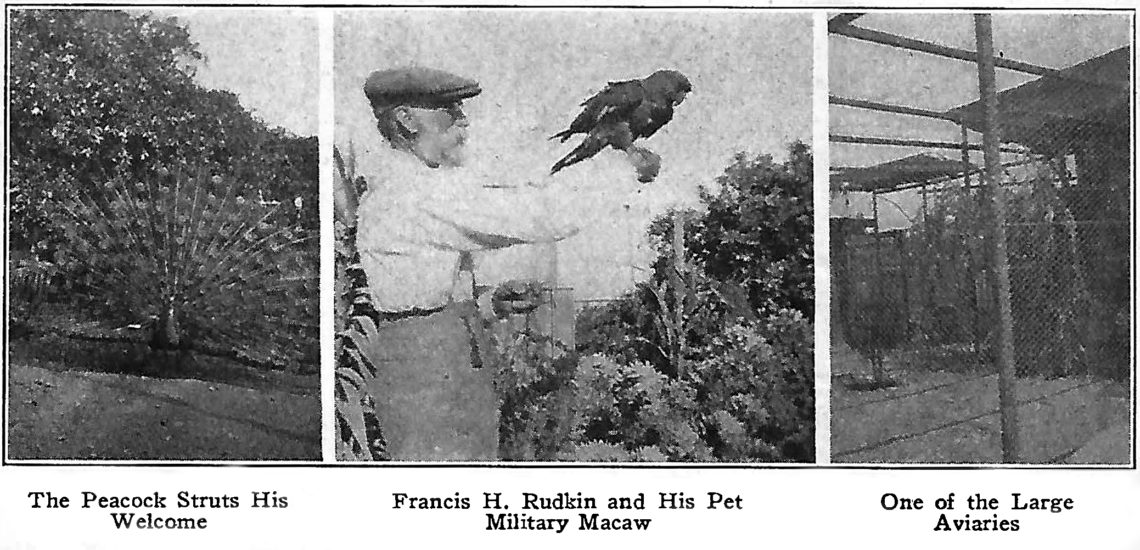Features
-
The Lutino Plum-headed Parakeet
Fabulous photos by Steve Duncan [PLUMHEADED PARAKEET (PSITTACULA CYANOCEPHALA) LUTINO MALE ] The Plum-headed Parakeet, Psittacula cyanocephala, is arguably the most beautiful of the smaller Asian parakeets. In comparison to other Psittacula, it is compact in size, but maintains its dignity because of its sleek physique, long elegant tail, and of course the customary psittacula demarcation above the neckline. Although the hen’s head remains a slate color, the cock’s handsomeness becomes obvious in maturity, becoming an exquisite purple-red color. Unlike other larger, boisterous, and audibly annoying Psittacula species, Plumheads in general are typically gentle, calm, and pleasantly quiet. When hand-fed, they can make wonderful pets and never seem to become…
-
A True Aviculturist
Nestling in the Santa Clara River Valley Just Out of Filmore, California Is the Charming Home of Francis H. Rudkin With Its Wonderful Collection By Dr. Dave Silverstone, Los Angeles, Calif. WHILE rambling through the country one day last Fall, I saw a Military Macaw circling over the orange grove. This was, indeed, a surprise and as the bird descended to one of the trees I could not resist the temptation to follow. The virtual paradise that greeted my eyes well repaid my insatiable curiosity. Nestling in the Santa Clara River Valley just out of Filmore, Calif., is this home. The owner is sure an avid aviculturist is the thought…
-
Avicultural Notes
The popularity of the Australian Shell Parrakeet (so-called love-bird of the trade) is growing by leaps and bounds. Hardly a day passes we do not receive letters from all over the country asking for information about breeding them, size of cages, what kind of food required when nesting, kind of nest, and a dozen other questions. Why doesn’t some of our members write down their own experience and let others profit thereby. A bird that is becoming more and more frequently seen even in the smaller pet shops is the Bengalese or Societyfinch. Large numcers of these have been brought over from Japan lately and this may account for its…
-
Cikananga Conservation Breeding Centre – Saving Asia’s Songbirds
NOTE: All photos copyright by Cikananga Conservation Breeding Centre The birdlife of South East Asia, particularly Indonesia, has been long adored by birdwatchers and aviculturists. Over the past couple of decades, ‘twitchers’ have noted a decline in the number of birds in some areas which formerly supported a wealth of avian activity. Whilst habitat loss is a huge factor in the decline of birds, the cage bird trade is decimating populations across Southeast Asia. Many species from this area are now commonplace in our aviaries or zoos, such as fairy bluebirds and shamas, but relatively few people are aware of the immense threat faced by these birds in their native…
-
Pick Your Color
(IMAGE: Yellow Zupreem pellets in the bottom of a ceramic bowl.) Whilst collecting dishes from my softbills, I will usually encounter certain colors of the pellets uneaten. I have also seen this in parrots. In a mix with red, orange, yellow and green, the red is almost always the first eaten. The remaining colors are selected by preference for eating by color until, the least favorite is left in the dish. If the dish is not refreshed, the birds will start eating the perceived inferior pellets – for the most part. It seems my Blue-naped mousebirds (Urocolius macrourus), are stubborn little creatures that draw a line in the dish and…
-
Back Yard Chickens: Pros and Cons
(IMAGE: PHOTO OF CHICKEN COOP IN SUSIE’S CHILDHOOD BACK YARD. SUSIE IS THE INDIAN PRINCESS BEYOND THE POLE ON THE LEFT. PHOTO BY J.S.RICHTER OF FRESNO) The earliest memories of my childhood in Fresno, CA, were of doing the chores for the hen house. I was in charge of raking the poop and removing it from the pens, to be used for my mom’s flowers. I also mowed our lawns and carted the clippings to the hen house, because my mom swore it made the egg yolks bright orange. I fed the hens laying pellets and collected the eggs several times a day. Crazy child that I was, I’d lift…
-
The Races of Amazon Aestiva
(IMAGE: BLUE FRONT AMAZON (AMAZONA AESTIVA) CHACO TYPE PHOTO STEVE DUNCAN) Carolus Linnaeus (Linné) published the 10th edition of his systematic list in 1758. His Systema Naturae gave order to the species concept, with a generic and a subspecific name—the so-called binominal nomenclature; the tenth edition is regarded as the starting point of zoological nomenclature. This concept allowed scientists worldwide to recognize the same individual by the same name; the use of common names typically proved tremendously erring, as different countries then as they do now use different common names for the same species. This scientific principal unquestionably advanced science tremendously and is still in use today. Linné named on…
